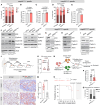TP53 missense-specific transcriptional plasticity drives resistance against cell cycle inhibitors in pancreatic cancer
- PMID: 40614202
- PMCID: PMC12227071
- DOI: 10.1126/sciadv.adu2339
TP53 missense-specific transcriptional plasticity drives resistance against cell cycle inhibitors in pancreatic cancer
Abstract
In ~70% of patients with pancreatic ductal adenocarcinoma, the TP53 gene acquires gain-of-function (GOF) mutations leading to rapid disease progression. Specifically, missense p53 (misp53) GOF mutations associate with therapy resistance and worse clinical outcomes. However, the molecular functions of distinct misp53 mutants in plasticity and therapy response remain unclear. Integrating multicenter patient data and multi-omics, we report that the misp53R273H/C mutant is associated with cell cycle progression and a basal-like state compared to the misp53R248W/Q mutant. Loss of misp53R273H/C decreased tumor growth and liver metastasis while prolonging survival in preclinical models. We found that misp53R273H/C specifically regulated the Rb/DREAM axis involved in cell cycle regulation. Notably, a clinical CDK4/6 inhibitor reduced misp53R273H/C mutant expression. However, it triggered MAPK/ERK-mediated resistance mechanisms, enhancing cell survival and resistance to CDK4/6 inhibitors. Combining MAPK/ERK and CDK4/6 inhibitors reduced misp53R273H/C-associated oncogenic functions. Thus, distinct misp53 mutants show unique cell-intrinsic plasticity, therapeutic vulnerabilities, and resistance mechanisms.
Figures






References
-
- Siegel R. L., Miller K. D., Wagle N. S., Jemal A., Cancer statistics, 2023. CA Cancer J. Clin. 73, 17–48 (2023). - PubMed
-
- Heinemann V., Boeck S., Perioperative management of pancreatic cancer. Ann. Oncol. 19 (Suppl. 7), vii273–vii278 (2008). - PubMed
-
- American Cancer Society, Facts & Figures 2024 (2024); https://cancer.org/research/cancer-facts-statistics/all-cancer-facts-fig.... - PMC - PubMed
-
- Sohal D. P. S., Kennedy E. B., Cinar P., Conroy T., Copur M. S., Crane C. H., Garrido-Laguna I., Lau M. W., Johnson T., Krishnamurthi S., Moravek C., O’Reilly E. M., Philip P. A., Pant S., Shah M. A., Sahai V., Uronis H. E., Zaidi N., Laheru D., Metastatic pancreatic cancer: ASCO guideline update. J. Clin. Oncol. 38, 3217–3230 (2020). - PubMed
MeSH terms
Substances
LinkOut - more resources
Full Text Sources
Medical
Research Materials
Miscellaneous

